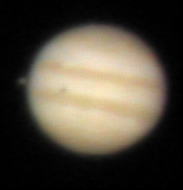Last updated: 16 February 2003
|
Last updated: 16 February 2003 |
Subject: My first light with the ETX125 Sent: Saturday, February 15, 2003 17:38:36 From: Damhof@home.nl (Jan Damhof) Just dropping a note about what a great observation session I had with my new ETX125. I waited 3 month for my etx to arrive, and the longer you have to wait and read about other peoples experience with the ETX125 the more you expect from the scope. Last Monday I finally had the chance to take my etx for a ride ! I had the moon, some clouds and city lights so not the best conditions. I had my first look at Jupiter, Saturn, Orion etc.. well what can say. My girl was surprised not seeing me jumping around of joy. It was nice, but not yet what I expected. The second night was already better, the weather was the same but, I started to know my ETX and started to learn how to us it ! But then there was the third night: From my observation notes on my site: members.home.nl/damhof/astro/ Thursday 9:00 "The sky is very clear now, but the moon is in the sky and 3/4 so no deepsky for the next few days. I did a Goto tour that went very well, He did put al the objects nice centered in the finder and almost all the time in the 26mm eyepiece. the planet were the best of this tour because of the seeing conditions, but there were some nice star clusters to ! And an old friend of my : NGC 869 and NGC 884 in Constellation Perseus, brought back some memories about the first time I played around with a borrowed telescope 15 year ago :) Around 9:00PM I had a look at Jupiter, and I noticed that one moon was very close to the edge of Jupiter. when I looked again 1 hour later I noticed two shadows on the surface of Jupiter. On real black spot and a light one. Checking a Jupiter moon calendar it seems that the moon Ganymedes was passing Jupiter and that both Ganymedes and it's shadow should be visible in a good telescope. And sure they were visible !! Woow great ! , I hoped that is was possible to see the moons of Jupiter like this but to be honest didn't expect it to be like this ! The moon is a real little disk, Ok .. you have to look very good and concentrate but it's definitely an disk. My Jupiter moon calendar told me that this transition should last till 2:00am. I got the day off tomorrow so I'm not going anywhere ! Going back inside now and then ( it was getting cold outside with a freezing -4 Celsius ) I was struck with the feeling of a "connection" of what was live going on outside, up there in the sky, 647.000.000 Km away from my garden. This feeling is were I bought my telescope for !! Around 1:00am the lighter disk ( Ganymedes self ) was not visible anymore, but I should become visible again as soon it "leaves" the surface of Jupiter. I decided to keep a constant eye on Jupiter from now on to see if I good observe the first gimps of Ganymedes "leaving"Jupiter. After a few minutes I indeed saw ganymedes appear as a little "bump" on the left site of Jupiter. In a few minutes time Ganymedes was "lose" again from Jupiter. I witnessed the live movement of a moon so fare away, I'm Impressed. I Managed to make a nice picture of Ganymedes a few minutes after "leaving" Jupiter. Get better with my camera BTW :) but definitely need a T-connector and adapter for my G2, I toke these pictures on a camera tripod setup. What did I learn for so fare about my ETX. First I need some dark skies to have a good view of Deepsky object. Second you really have to learn how to use a telescope and how to observe with it. Just looking for a few seconds into the eyepiece will not give you what your are looking for ( maybe with the moon ) You will need to take your time to look "through" the unstable air, have darkness adapted eye's and the knowledge what to look for to get the best results for your observations. ( there is an good article about that on weasners site ) I still need some moon less night out in the fields to see what I get under dark sky conditions, But for so far I think I gonna have lot's of fun with this Telescope !" mike, There is still one Questioning I got, I did try to look at some bright double stars, but was unable to get a sharp view of it. They had a lot of "little sparkeling flames". The star clusters got nice little points, the sharpness of the moon and Jupiter changed with in the sec by the influence of the atmosphere but were some time very sharp so the optics of the scope seems ok. But the brighter stars were hard to get a got focus on. Is this because the seeing is bad ? or should I worry about my optics. maybe the eyepieces ? I added the Image I made of Jupiter and ganymedes, maybe you can put it on your planet image page, It's a stacked picture of the best 4 out of 10. I used registax. I gonna have more info on my site members.home.nl/damhof/astro/ thx for your great site !

Mike here: "Twinkling stars" may be caused by thermal currents inside the telescope tube or other factors that can affect seeing, such as heat from rooftops, pavement, etc. as well as normal atmospheric conditions.
Return to the top of this page.
Go back to the User Observations page.
Go back to my ETX Home Page.